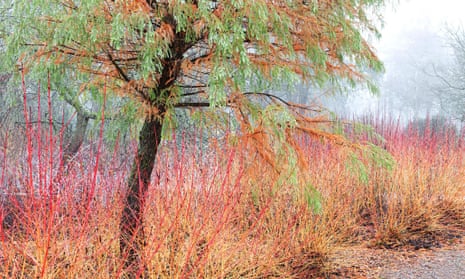You need a lift in February when the winter takes its toll. So, with the backdrop of a yew hedge and behind that the red of a tile-hung house, I set out a garden with coloured-stemmed cornus as its base.
Elsewhere in the garden we have the winter-flowering Cornelian cherry, Cornus mas, popping acid-green flowers. But the cornus in the new planting were selected specifically for their stems. Coloured-stemmed varieties are often used in car parks, but don’t hate them because of that. Grown well – and this is down to good pruning – they are easy and reliable garden plants. All they need is a sunny position and hearty soil. Removing a third of their growth to the base at the end of the winter will encourage the newest stems with the most brilliant colour.
Cornus alba ‘Sibirica’ is bright crimson but, en masse and in bright sun, it shines flamingo pink. I have combined it with the black-stemmed Cornus alba ‘Kesselringii’ to keep things smart. The stems of ‘Kesselringii’ are charcoal black. In their own way they are as dramatic as the red, but they need the right partner if they are not to be lost. I have grown them with white hellebores at their feet in the past and among straw-coloured grasses, such as Stipa ‘Karl Foerster’, to heighten their darkness. They also look wonderful against a pale wall or with the white of birch as a backdrop. Black and white in winter is always rather wonderful.

The lime green of Cornus stolonifera ‘Flaviramea’ is at the other end of the colour spectrum from ‘Sibirica’ but easily as intense. I would never put them together for fear of an almighty clash, but I would love to see the green with the black of ‘Kesselringii’. You need lots of space to try these experiments and I still have this one up my sleeve, using the acid green of the cornus with the brown and rust of chestnut-stemmed willows and sedges. Salix daphnoides ‘Aglaia’ and Carex testacea would look wonderful. The white-stemmed Rubus thibetanus ‘Silver Fern’ would also work well.
I am growing our native dogwood, Cornus sanguinea, as a shelter belt and in hedges where the ground is too wet for hawthorn. The winter stems are a rich mahogany brown. ‘Midwinter Fire’ is a fine selection, which channels its native vigour into an extraordinary blaze of orange stems tipped with coral to further heighten the spectacle.
Regular pruning is the key to promoting good colour. I like to wait until the end of winter when I see the buds just beginning to swell before stripping out a portion of the growth. Some books recommend coppicing to the ground every year, but I prefer to keep the structure and thin out the eldest stems by a third. A good feed after pruning and a mulch will encourage regrowth under the cover of summer greenery. As the leaves drop, the colourful stems flare just when you need them.
Get growing
Cornus takes easily from hardwood cuttings. Save prunings and plunge a few pencil-thick lengths into the ground by your mother plant. They will be rooted and ready to lift within a year.
Follow the Observer Magazine on Twitter @ObsMagazine

Comments (…)
Sign in or create your Guardian account to join the discussion